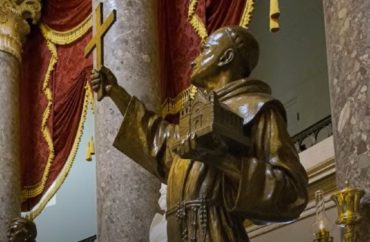
Refused to say if it plans to publicly display the statue
A Catholic university does not appear to have any plans to return a statue of St. Junípero Serra to a public place on campus.
The University of San Diego removed the statue in July after other statues of the 18th-century California priest were vandalized. Critics accuse Serra of mistreatment of Native Americans during his time running missions in California, though religious leaders have disputed this characterization.
Now the university will not say when, if ever, it plans to publicly display the statue.
University officials told the Catholic News Agency in July that it was moved to “temporary storage” after the Archdiocese of Los Angeles’ bishop published a letter criticizing the vandalism against statues of Serra. The university is not within the jurisdiction of the archdiocese.
“Faced with the possibility of vandalism, we are taking increased security precautions at the historic missions located in the Archdiocese of Los Angeles,” Archbishop José Gómez wrote on June 29.
“Unfortunately, we will probably have to relocate some statues to our beloved saint or risk their desecration.”
The Diocese of San Diego told The College Fix via email that the statue was removed for “protection” and referred The Fix to a statement from the bishops of California defending the legacy of Serra.
The Fix specifically asked the university for an update on the statues and if the university planned to return the statue to a public place on campus.
The school’s spokesperson dodged that question and ignored a follow-up request for comment on a planned return.
“In the past year, the University of San Diego has addressed some of the issues surrounding the recognition of injustice to Native Americans and in the mission era,” university spokesperson Lissette Martinez told The Fix via email. “In response, Serra Hall was renamed to Saints Kateri Tekawitha and Junipero Serra Hall.”
“A tapestry image of each saint was commissioned, and these tapestries are currently displayed inside Saints Tekawitha and Serra Hall,” Martinez said.
“St. Serra, America’s first Hispanic saint and missionary who brought Christianity to these lands, worked tirelessly to eliminate oppression that was clearly a part of the mission era.”
Martinez did not respond to a follow-up email reiterating a request for information on plans to once again display the statue publicly.
At least two statues of the saint had been torn down when the university made its decision.
“On June 19 a statue of the saint in San Francisco’s Golden Gate Park was toppled and desecrated. Archbishop Gómez also said a Serra statue in the plaza outside the archdiocese’s first church, Nuestra Señora Reina de los Angeles, in downtown Los Angeles also was torn down,” Tablet reported.
The legacy of Serra is not a clear cut one of oppression.
A June article in the Catholic News Agency pointed out that Serra defended the rights of indigenous people.
“Serra specifically advocated for the rights of Native peoples, at one point drafting a 33 point ‘bill of rights’ for the Native Americans living in the mission settlements and walking all the way from California to Mexico City to present it to the viceroy,” the Catholic website said.
Archbishop Salvatore Cordileone, the leader of the Archdiocese of San Francisco, defended Serra’s legacy.
He said the saint “was a profound lover of all people and especially of the indigenous peoples he came to serve.”
He pointed out in his Washington Post op-ed in June:
Serra repeatedly intervened for mercy on behalf of indigenous rebels against Spanish authorities. He famously walked to Mexico City with a painful ulcerated leg to obtain the authority to discipline the military who were abusing the indigenous people. Then he walked back. …History is often not kind to heroes. George Washington sacrificed to found a great country. He also owned slaves he freed only upon his death. Leland Stanford, founder of a great university, was an abolitionist but also continued genocidal policies against the Indians.
In July, the California city of Ventura removed the statue of the Catholic priest. That decision led to a threat of legal action from the Thomas More Society, a nonprofit religious freedom law firm.
In 2015, students at the the University of San Diego demanded the renaming of the Serra Hall named for the saint, accusing him of a massacre of Native Americans, though the activists did not explain what role Serra played in the death of the indigenous people.
MORE: Catholic university cancels Catholic writer Flannery O’Connor
IMAGE: Wall Street Journal/Youtube
Like The College Fix on Facebook / Follow us on Twitter





Please join the conversation about our stories on Facebook, Twitter, Instagram, Reddit, MeWe, Rumble, Gab, Minds and Gettr.